Question 1.
a) If p(x) = 5x7- 6x5+ 7x - 6, find
- i) coefficient of x5
- ii) degree of p(x)
- iii) constant term.
Answer:
Given p(x) = 5x7- 6x5+ 7x - 6
i) coefficient of x5is -6
ii) degree of p(x) is 7
iii) constant term is -6
b) Write three more polynomials and create three questions for each of them.
Answer:
Polynomial - 1: P(x) = x + 5
Questions:
1) What is the order of given polynomial?
2) What are maximum possible zeroes to the above polynomial?
3) What is the zero value of given polynomial?
Polynomial - 2: P(x) = x2- 5x + 6
Questions:
1) What is the sum of zeroes of given polynomial?
2) What is the product of zeroes of it?
3) At how many points, do the polynomial crosses x-axis?
Polynomial - 3: P(x) = axp+ bx2+ cx + d
Questions:
1) What will be the value of ‘p’, if the given is cubic polynomial?
2) What is the product of zeroes of it?
3) What can you say about the value of ‘a’ if the given is a cubic polynomial?
Question 3.
If p(t) = t3 – 1, find the values of p(1), p(-1), p(0), p(2), p(-2).
Answer:
Given polynomial p(t) = t3- 1
p(1) = 13- 1 = 1 - 1 = 0
p(-1) = (-1)3- 1 = - 1 - 1 = - 2
p(0) = 03- 1 = 0 - 1 = - 1
p(2) = 23- 1 = 8 - 1 = 7
p(-2) = (-2)3- 1 = - 8 - 1 = - 9
Question 4.
Check whether - 2 and 2 are the zeroes of the polynomial x4- 16.
Answer:
Given polynomial is x4- 16
Let p(x) = x4- 16
We have p(-2) = (-2)4- 16
= 16 - 16 = 0 and
p(2) = (2)4- 16
= 16 - 16 = 0
p(-2) = 0 and p(2) = 0.
So these are zeroes of the polynomial.
Question 5.
Check whether 3 and -2 are the zeroes of the polynomial p(x) when p(x) = x2- x - 6.
Answer:
Given polynomial p(x) = x2- x - 6
We have, p(3) = 32- 3 - 6
= 9 - 3 - 6
= 9 - 9
= 0 and
p(-2) = (-2)2- (-2) - 6
= 4 + 2 - 6
= 6 - 6
= 0
We see that p(3) = 0 and p(-2) = 0
∴ 3 and - 2 are the zeroes of the polynomial p(x).
Question 1.
The graphs of y = p(x) are given in the figure below, for some polynomials p(x). In each case, find the number of zeroes of p(x).
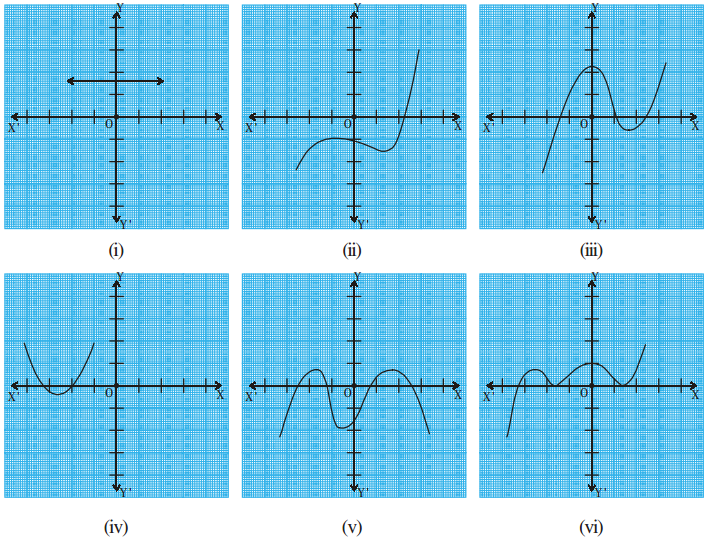
Answer:
- i) There are no zeroes as the graph does not intersect the X - axis.
- ii) The number of zeroes is one as the graph intersects the X - axis at one point only.
- iii) The number of zeroes is three as the graph intersects the X - axis at three points.
- iv) The number of zeroes is two as the graph intersects the X - axis at two points.
- v) The number of zeroes is four as the graph intersects the X - axis at four points.
- vi) The number of zeroes is three as the graph intersects the X - axis at three points.
Question 2.
Find the zeroes of the given polynomials,
- (i) p(x) = 3x
- (ii) p(x) = x2+ 5x + 6
- (iii) p(x) = (x + 2) (x + 3)
- (iv) p(x) = x4- 16
Answer:
i) Given p(x) = 3x
Let p(x) = 0
So, 3x = 0
x = 0/3 = 0,
Zeroes of p(x) = 3x is zero.
∴ No. of zeroes is one.
ii) Given p(x) = x2 + 5x + 6 is a quadratic polynomial.
It has atmost two zeroes.
To find zeroes, let p(x) = 0
⇒ x2+ 5x + 6 = 0
⇒ x2+ 3x + 2x + 6 = 0
⇒ x(x + 3) + 2 (x + 3) = 0
⇒ (x + 3) (x + 2) = 0
⇒ x + 3 = 0 or x + 2 = 0
⇒ x = -3 or x = -2
Therefore the zeroes of the polynomial are -3 and -2.
iii) Given p(x) = (x + 2) (x + 3)
It is a quadratic polynomial.
It has atmost two zeroes.
Let p(x) = 0
⇒ (x + 2) (x + 3) = 0
⇒ (x + 2) = 0 or (x + 3) = 0
⇒ x = -2 or x = -3
Therefore the zeroes of the polynomial are -2 and – 3.
iv) Given p(x) = x4- 16 is a biquadratic polynomial. It has atmost two zeroes.
Let p(x) = 0
⇒ x4- 16 = 0
⇒ (x2)2- 42= 0
⇒ (x2- 4) (x2+ 4) = 0
⇒ (x + 2) (x - 2) (x2+ 4) = 0
⇒ (x + 2) = 0 or (x - 2) = 0 or (x2+ 4) = 0
⇒ x = -2 (or) x = 2 (or) x2= -4
Therefore the zeroes of the polynomial are 2, - 2, we do not consider √-4 since it is not real.
Question 3.
Draw the graphs of the given polynomial and find the zeroes. Justify the answers,
- i) p(x) = x2- x - 12
- ii) p(x) = x2- 6x + 9
- iii) p(x) = x2- 4x + 5
- iv) p(x) = x2+ 3x - 4
- v) p(x) = x2- 1
Answer:
i) Given polynomial p(x) = x2- x - 12.
List of values of p(x):

Now, let’s locate the points listed above on a graph paper and draw the graph.
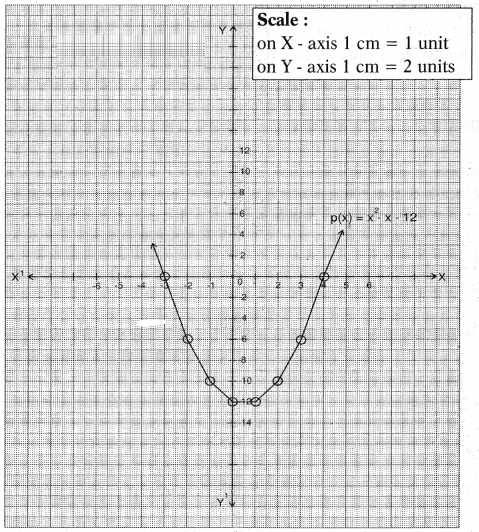
Result: We observe that the graph cuts the X - axis at (-3, 0) and (4, 0).
So, the zeroes of the polynomial are -3 and 4.
Justification:
Given p(x) = x2- x - 12 = 0
⇒ x2- 4x + 3x - 12 = 0
⇒ x(x - 4) + 3(x - 4) = 0
⇒ (x - 4) (x + 3) = 0
⇒ x - 4 = 0 and x + 3 = 0
x = 4 and x = - 3
ii) Given polynomial p(x) = x2- 6x + 9
List of values of p(x):
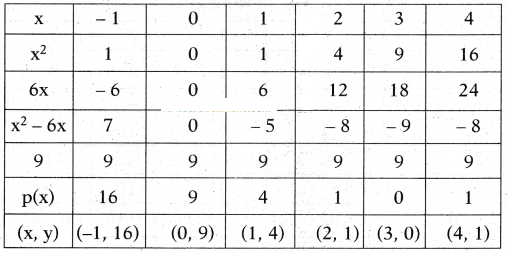
Now, let’s locate the points listed above on a graph paper and draw the graph.
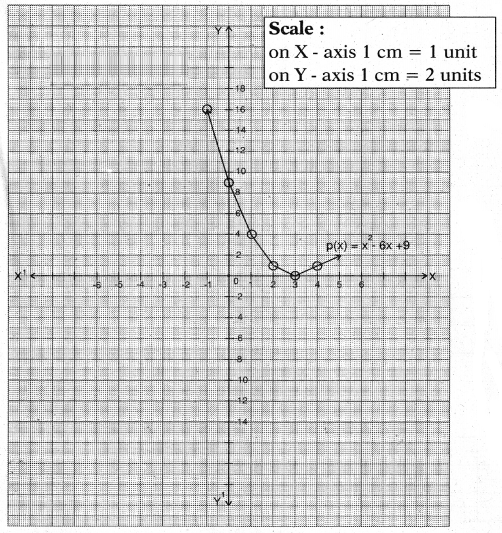
Result: We observe that the graph cuts the X - axis at (3, 0).
So, the zeroes of the given polynomial are same i.e., 3.
Justification:
Given p(x) = x2- 6x + 9
⇒ x2- 3x - 3x + 9 = 0
⇒ x(x - 3) - 3(x - 3) = 0
⇒ (x - 3) (x - 3) = 0
⇒ x - 3 = 0 and x - 3 = 0
x = 3 and x = 3
iii) Given polynomial p(x) = x2- 4x + 5
List of values of p(x):
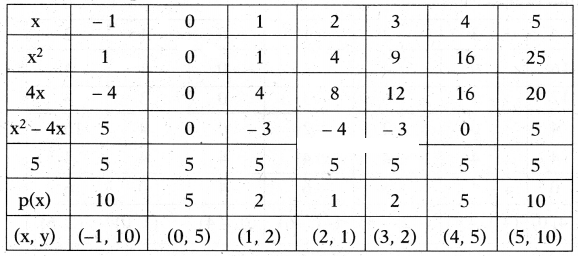
Now, let’s locate the points listed above on a graph paper and draw the graph.
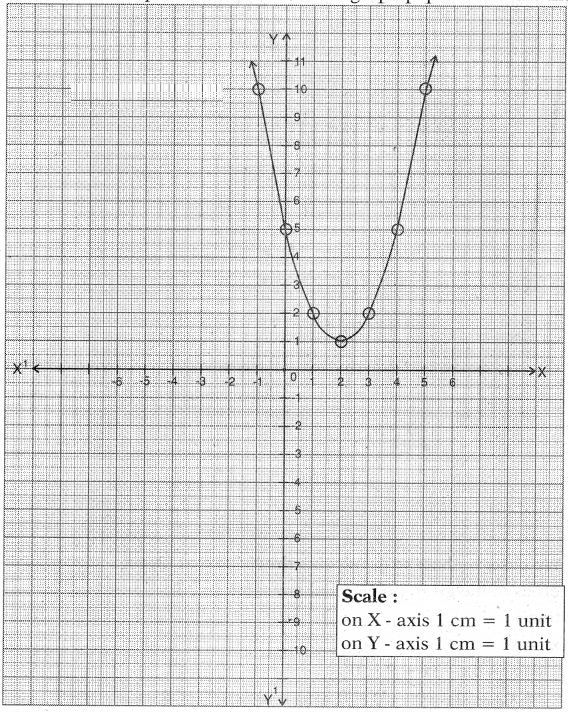
Result: We observe that the graph does not cut the X - axis at any point.
So, the quadratic polynomial p(x) has no zeroes.
Justification: For the given p(x) = x2- 4x + 5 not possible to split in factors.
iv) Given polynomial p(x) = x2+ 3x - 4.
List of values of p(x):
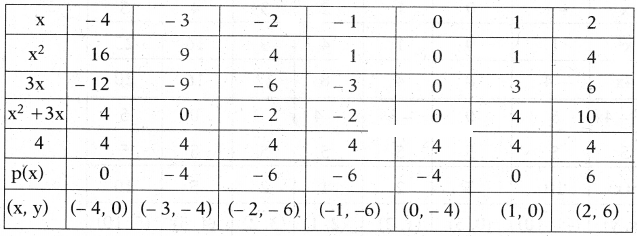
Now, let’s locate the points listed above on a graph paper and draw the graph.
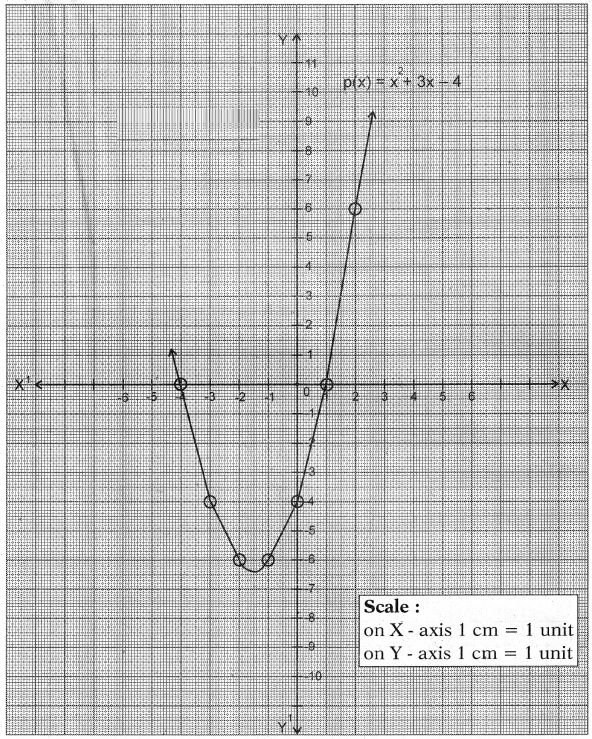
Result: We observe that the graph cuts the X – axis at (-4, 0) and (1, 0).
So, the zeroes of the polynomial are -4 and 1.
Justification:
Given p(x) = x2+ 3x - 4 = 0
⇒ x2+ 4x - x - 4 = 0
⇒ x(x + 4)- 1(x + 4) = 0
⇒ (x + 4) (x - 1) = 0
⇒ x + 4 = 0 and x - 1 = 0
x = - 4 and x = 1
v) Given polynomial p(x) = x2- 1
List of values of p(x):
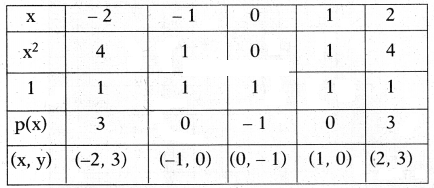
Now, let’s locate the points listed above on a graph paper and draw the graph.
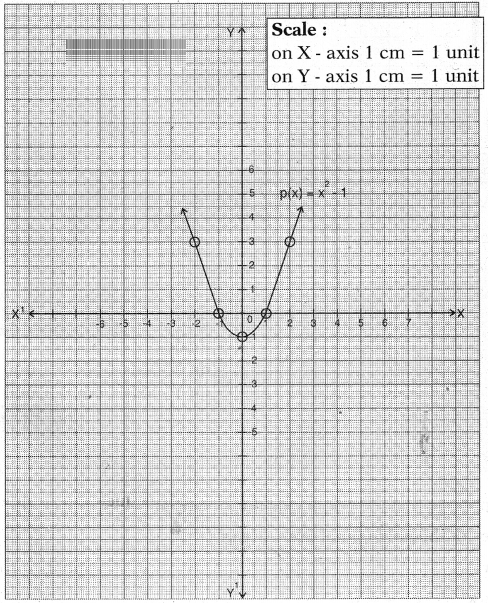
Result: We observe that the graph cuts the X - axis at (-1, 0) and (1,0).
So, the zeroes of the polynomial are - 1 and 1.
Justification:
Given p(x) = x2- 1 = 0
⇒ p(x) = (x + 1) (x - 1) = 0 [∵ a2- b2= (a + b) (a - b)]
⇒ x + 1 = 0 and x - 1 = 0
x = -1 and x = 1
Question 4.
Why are 1/4 and -1 zeroes of the polynomial p(x) = 4x2+ 3x - 1 ?
Answer:
Given polynomial p(x) = 4x2+ 3x - 1
Given zeroes are 1/4 and -1
Let x = 1/4
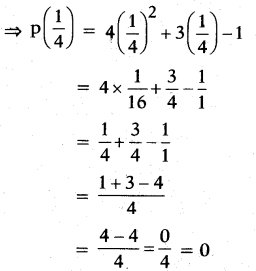
Let x = -1
⇒ p(-1) = 4(-1)2+ 3(-1)-1 = 4 - 3 - 1 = 4 - 4 = 0
∴ P(14) = 0 and p(-1) = 0
So these values are zeroes of the polynomial p(x).
Question 1.
Find the zeroes of the following quadratic polynomials and verify the relationship between the zeroes and the coefficients.
- i) x2- 2x - 8
- ii) 4s2- 4s + 1
- iii) 6x2- 3 - 7x
- iv) 4u2+ 8u
- v) t2- 15
- vi) 3x2- x - 4
Answer:
i) Given polynomial is x2- 2x - 8
We have x2- 2x - 8 = x2- 4x + 2x - 8
= x(x - 4) + 2(x - 4)
= (x - 4) (x + 2)
So, the value of x2- 2x - 8 is zero
when x - 4 = 0 or x + 2 = 0 i.e.,
when x = 4 or x = -2
So, the zeroes of x2- 2x - 8 are 4 and -2.
Sum of the zeroes = 4 - 2 = 2 Coefficient of ,x -(-2)
= - Coefficient of x / Coefficient of x2 =-(-2)/1= 2
And product of the zeroes = 4 × (-2) = -8
= Constant term/Coefficient ofx2=-8/1= -8
ii) Given polynomial is 4s2- 4s + 1
We have, 4s2- 4s + 1
= 4s2- 2s - 2s + 1
= 2s (2s - 1) - 1(2s - 1)
= (2s - 1) (2s - 1)
= (2s - 1)2
So, the value of 4s2 - 4s + 1 is zero
when 2s-1 = 0 or s =1/2
∴ Zeroes of the polynomial are 1/2 and 1/2
∴ Sum of the zeroes =1/2+1/2= 1.
= - Coefficient of s /Coefficient of s2 = - ?4/4 = 1
And product of the zeroes = (12)×(12) = 1/4
= Constant term/Coefficient of x2 = 1/4
iii) Given polynomial is 6x2- 3 - 7x
We have, 6x2- 3 - 7x = 6x2- 7x - 3
= 6x2- 9x + 2x - 3
= 3x(2x - 3) + 1(2x - 3)
= (2x - 3) (3x + 1)
The value of 6x2- 3 - 7x is zero, when the value of (3x +1) (2x - 3) is 0
i.e., when 3x + 1 = 0 and 2x - 3 = 0
3x = -1 and 2x = 3
x =-1/3 and x = 3/2
there4; The zeroes of 6x2- 3 - 7x =-1/3 and 3/2
∴ Sum of the zeroes =1/3+3/2=7/6.
= - Coefficient of x /Coefficient of x2 = ?(?7)/6 = 7/6
And product of the zeroes = (?1/3)×(3/2) = ?1/2
= Constant term / Coefficient of x2 = ?3/6 = ?1/2
iv) Given polynomial is 4u2+ 8u
We have, 4u2+ 8u = 4u (u + 2)
The value of 4u2+ 8u is 0,
when the value of 4u(u + 2) = 0, i.e.,
when u = 0 or u + 2 = 0, i.e.,
when u = 0 (or) u = - 2
∴ The zeroes of 4u2+ 8u are 0 and - 2.
Therefore, sum of the zeroes = 0 + (-2) = -2
= - Coefficient of u /Coefficient of u2 = ?8/4 = -2
And product of the zeroes 0 . (-2) = 0
= Constant term / Coefficient of u2 = 0/4 = 0
v) Given polynomial is t2- 15.
We have, t2- 15 = (t - √15 ) (t + √l5)
The value of t2- 15 is 0,
when the value of (t - √15 ) (t + √l5) = 0, i.e.,
when t - √15 = 0 or t + √15 = 0, i.e.,
when t = √15 (or) t = -√15
∴ The zeroes of t2- 15 are √15 and -√15.
Therefore, sum of the zeroes = √15 + (-√15) = 0
= -Coefficient of t/Coefficient of t2= - 0/1 = 0
And product of the zeroes √15 × (-√15) = -15
=Constant term/Coefficient of t2=-15/1= -15
vi) Given polynomial is 3x2- x - 4
we have, 3x2- x - 4 = 3x2+ 3x - 4x - 4
= 3x(x + 1) - 4(x + 1)
= (x + 1) (3x - 4)
The value of 3x2 - x - 4 is 0 when the value of (x + 1) (3x - 4) is 0.
i.e., when x + 1 = 0 or 3x - 4 = 0
i.e., when x = -1 or x = 4/3
∴ The zeroes of 3x2 - x - 4 are -1 and 4/3
Therefore, sum of the zeroes = -1 + 4/3=-3+4/3=1/3
= - Coefficient of x/Coefficient of x2=-(-1)/3=1/3
And product of the zeroes -1 × 4/3 =-4/3
=Constant term/Coefficient of x2=-4/3
Question 2.
Find the quadratic polynomial in each case, with the given numbers as the sum and product of its zeroes respectively.
- i)1/4, -1
- ii) √2,1/3
- iii) 0, √5
- iv) 1, 1
- v) -1/4,1/4
- vi) 4, 1
Answer:
Let the polynomial be ax2+ bx + c
and its zeroes be α and β.
i) Here, α + β =1/4 and αβ = -1
Thus, the polynomial formed = x2 - (sum of the zeroes)x + product of the zeroes
= x2 -(1/4)x - 1
= x2- x/4 - 1
The other polynomials are (x2-x/4 - 1)
then the polynomial is 4x2 - x - 4.
ii) Here, α + β = √2 and αβ =1/3
Thus, the polynomial formed = x2 - (sum of the zeroes)x + product of the zeroes
= x2 – (√2)x +1/3
= x2 – √2x +1/3
The other polynomials are (x2 - √2x +1/3)
then the polynomial is 3x2 - 3√2x + 1.
iii) Here, α + β = 0 and αβ = √5
Thus, the polynomial formed = x2 - (sum of the zeroes)x + product of the zeroes
= x2 - (0)x + √5
= x2 + √5
iv) Let the polynomial be ax2+ bx + c and its zeroes be α and β.
Then α + β = 1 =-(-1)1 =-b/a and
αβ = 1 = latex]frac{1}{1}[/latex] =c/a
If a = 4, then b = 1 and c = 1
∴ One quadratic polynomial which satisfies the given conditions is 4x2+ x + 1.
v) Let the polynomial be ax2+ bx + c and its zeroes be α and β.
Then α + β =-1/4 =-b/a and
αβ =1/4=c/a
If a = 4, then b = 1 and c = 1
∴ One quadratic polynomial which satisfies the given conditions is 4x2+ x + 1.
vi) Let the polynomial be ax2+ bx + c and its zeroes be α and β.
Then α + β = 4 =-(-4)/1 =-b/a and
αβ = 1 = 1/1 = c/a
If a = 1, then b = -4 and c = 1
∴ One quadratic polynomial which satisfies the given conditions is x2 - 4x + 1.
Question 3.
Find the quadratic polynomial, for the zeroes α, β given in each case.
i) 2, -1
ii) √3, -√3
iii) 1/4, -1
iv) 1/2, 3/2
Answer:
i) Let the polynomial be ax2 + bx + c, a ≠ 0 and its zeroes be α and β.
Here α = 2 and β = - 1
Sum of the zeroes = α + β = 2 + (-l) = 1
Product of the zeroes = αβ = 2 × (-1) = -2
Therefore the quadratic polynomial ax2 + bx + c is x2 - (α + β)x + αβ = [x2 - x - 2]
the quadratic polynomial will be x2 - x - 2.
ii) Let the zeroes be α = √3 and β = -√3
Sum of the zeroes = α + β
= √3 + (-√3) = 0
Product of the zeroes = αβ
= √3 × (-√3) = -3
∴ The quadratic polynomial
ax2 + bx + c is [x2 - (α + β)x + αβ]
= [x2 - 0.x + (-3)] = [x2 - 3]
the quadratic polynomial will be x2 - 3.
iii) Let the zeroes be α = 14 and β = -1
Sum of the zeroes = α + β
= 1/4 + (-1) = 1+(?4)/4 = ?3/4
Product of the zeroes = αβ
= 1/4 × (-1) = ?14
∴ The quadratic polynomial
ax2 + bx + c is [x2 - (α + β)x + αβ]
= [x2 - (?3/4).x + (?1/4)]
the quadratic polynomial will be 4x2 + 3x - 1.
iv) Let the zeroes be α = 12 and β = 32
Sum of the zeroes = α + β
= 1/2 + 3/2 = 1+3/2 = 42 = 2
Product of the zeroes = αβ
= 1/2 × 3/2 = 3/4
∴ The quadratic polynomial
ax2 + bx + c is [x2 - (α + β)x + αβ]
= [x2 - 2x + (3/4)]
the quadratic polynomial will be 4x2 - 8x + 3.
Question 4.
Verify that 1, -1 and -3 are the zeroes of the cubic polynomial x3 + 3x2 - x - 3 and check the relationship between zeroes and the coefficients.
Answer:
Given cubic polynomial
p(x) = x3 + 3x2 - x - 3
Comparing the given polynomial with ax3 + bx2 + cx + d, we get a = 1, b = 3, c = -1, d = -3
Futher given zeroes are 1,-1 and - 3
p(1) = (1)3 + 3(1)2 - 1 - 3
= 1 + 3 - 1 - 3 = 0
p(-1) = (-1)3 + 3(-1)2 - 1 - 3
= -1 + 3 + 1 - 3 = 0
p(-3) = (-3)3 + 3(-3)2 - (-3) - 3
= -27 + 27 + 3 - 3 = 0
Therefore, 1, -1 and -3 are the zeroes of x3 + 3x2 - x - 3.
So, we take α = 1, β = -1 and γ = -3 Now,
α + β + γ = 1 + (-1) + (-3) = -3
αβ + βγ + γα = 1(-l) + (-1) (-3) + (-3)1
= -1 + 3 - 3 = -1
= c/a = ?1/1 = -1
αβγ = 1 (-1) (-3) = 3 = ?d/a = ?(?3)/1 = 3
Question 1.
Divide the polynomial p(x) by the polynomial g(x) and find the quotient and remainder in each of the following:
i) p(x) = x3 - 3x2 + 5x - 3, g(x) = x2 - 2
ii) p(x) = x4 - 3×2 + 4x + 5, g(x) = x2 + 1 - x
iii) p(x) = x4 - 5x + 6, g(x) = 2 - x2
Answer:
i) Given polynomials are
p(x) = x3 - 3x2 + 5x - 3 and
g(x) = x2 - 2
Here, dividend and divisor are both in standard forms.
So, we have
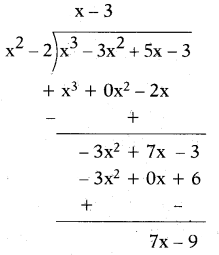
∴ The quotient is x - 3 and the remainder is 7x - 9.
ii) Given polynomials are
p{x) = x4 - 3x2 + 4x + 5 and
g(x) = x2 + 1 - x
Here, the dividend is already in the standard form and the divisor is not in the standard form. It can be written as x2 - x + 1.
We have,
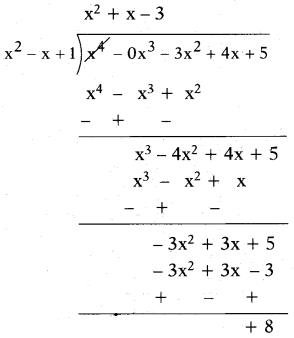
∴ The quotient is x2 + x - 3 and the remainder is + 8.
iii) Given polynomials are
p(x) = x4 - 5x + 6 and
g(x) = 2 - x2
Here, the dividend is already in the standard form and the divisor is not in the standard form. It can be written as -x2 + 2.
So, we have
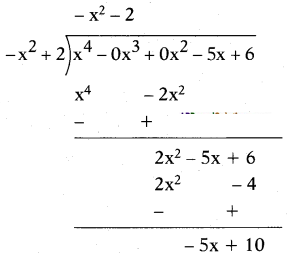
∴ The quotient is -x2 - 2 and the remainder is -5x + 10.
Question 2.
Check in which case the first polynomial is a factor of the second polynomial by dividing the second polynomial by the first polynomial:
i) t2- 3, 2t4+ 3t3- 2t2- 9t - 12
ii) x2+ 3x + 1, 3x4+ 5x3- 7x2+ 2x + 2
iii) x3- 3x + 1, x5- 4x3+ x2+ 3x + 1
Answer:
i) Given first polynomial is t2- 3.
Second polynomial is
2t4+ 3t3- 2t2- 9t - 12.
Let us divide 2t4+ 3t3- 2t2- 9t - 12 by t2- 3, we get
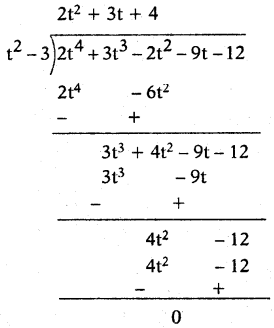
Since the remainder is 0, therefore, t2- 3 is a factor of 2t4+ 3t3- 2t2- 9t - 12.
ii) Given first polynomial is x2+ 3x + 1
Second polynomial is 3x4+ 5x3- 7x2+ 2x + 2
Let us divide 3x4+ 5x3- 7x2+ 2x + 2 by x2+ 3x + 1, we get
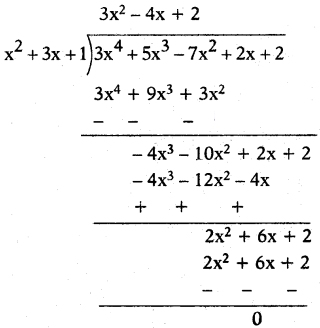
Since the remainder is 0, therefore x2+ 3x + 1 is a factor of 3x4+ 5x3- 7x2+ 2x + 2.
iii) Given first polynomial = x3- 3x + 1
Second polynomial = x5- 4x3+ x2+ 3x + 1
Let us divide x5- 4x3+ x2+ 3x + 1 by x3- 3x + 1, we get
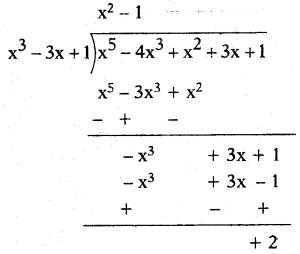
Here, remainder is 2(≠ 0).
Therefore, x3- 3x + 1 is not a factor of x5- 4x3+ x2+ 3x + 1.
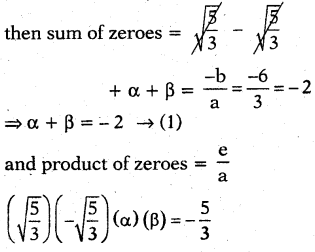
= 4 - 4 = 0
α - β = 0 …. (2)
Now solving (1) and (2) we get

⇒ α = -1, β = -1
Then the remaining the zeroes are -1 and -1.
Hence all zeroes of it = - √5/3, √5/3, -1, -1.
Question 4.
On dividing x3- 3x2+ x + 2 by a polynomial g(x), the quotient and remainder were x - 2 and -2x + 4, respectively. Find g(x).
Answer:
Given, p(x) = x3- 3x2+ x + 2
q(x) = x - 2 and
r(x) = -2x + 4
By division algorithm, we know that Dividend = Divisor × Quotient + Remainder
p(x) = q(x) × g(x) + r(x)
Therefore, x3- 3x2+ x + 2
= (x - 2) × g(x) + (- 2x + 4)
⇒ x3- 3x2+ x + 2 + 2x - 4 = (x - 2)× g(x)
g(x) = x3?3x2+3x?2/x?2
On dividing x3 - 3x2 + x + 2, by x - 2, we get
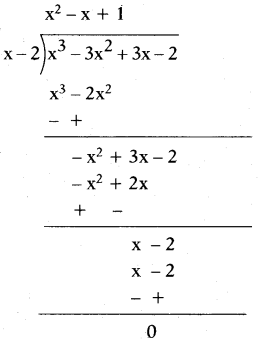
First term of g(x) = x
3/x = x
2
Second term of g(x) = ?x
2/x = -x
Third term of g(x) = xx = 1
Hence, g(x) = x
2 - x + 1.
Question 5.
Give examples of polynomials p(x), g(x), q(x) and r(x), which satisfy the division algorithm and
- i) deg p(x) = deg q(x)
- ii) deg q(x) = deg r(x)
- iii) deg r(x) = 0
Answer:
Let q(x) = 3x2+ 2x + 6, degree of q(x) = 2
p(x) = 12x2+ 8x + 24, degree of p(x) = 2
Given degree p(x) = degree q(x)
i) Using division algorithm,
We gave, p(x) = q(x) × g(x) + r(x)
On dividing 12x2 + 8x + 24 by 3x2+ 2x + 6, we get
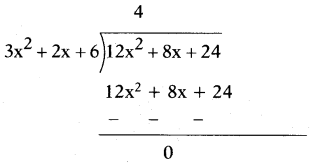
Since, the remainder is zero, therefore 3x2+ 2x + 6 is a factor of 12x2+ 8x + 24.
∴ g(x) = 4 and r(x)= 0
ii) Let p(x) = x5+ 2x4+ 3x3+ 5x2+ 2
q(x) = x2+ x + 1, degree q(x) = 2
Given degree q(x) = degree r(x)
On dividing x5+ 2x4+ 3x3+ 5x2+ 2 by x2+ x + 1, we get
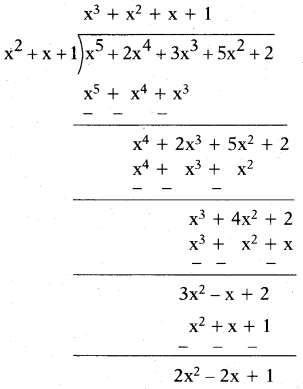
Here, g(x) = x3+ x2+ x + 1 and r(x) = 2x2- 2x + 1
degree of r(x) = 2.
∴ deg g(x) = deg r(x).
iii) Let p(x) = 2x4+ 8x3+ 6x2+ 4x + 12, r(x) = 2
Here, degree r(x) = 0
On dividing 2x4+ 8x3+ 6x2+ 4x + 12 by 2, we get
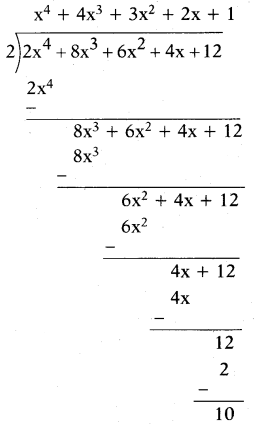
Here, g(x) = x4+ 4x3+ 3x2+ 2x + 1 and r(x) = 10
so degree of r(x) = 0